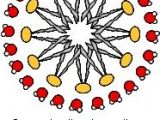A team of Princeton researchers has untangled the mystery behind a puzzling phenomenon in the world of nanotechnology. The scientists first observed more than a decade ago that when tiny aggregates of molecules, such as very small soap bubbles, are placed on a plane surface, they self-assembly in a surprising structure: one which resembles a Quonset hut (like the ones in this picture).
Why does this happen, and how could such a structure spontaneously appear and resist?
Dudley Saville, Ilhan Aksay and Roberto Car discovered that they and other researchers in the field of nanotechnology had been using a flawed assumption: they believed that in response to the texture of the graphite surface beneath them, the tiny soap aggregates assembled themselves into static 'Quonset Hut' shapes that stayed put.
However, the Princeton scientists realized that the structures were in fact highly dynamic. The discovery was made possible by the new atomic force microscope imaging done by research associate Hannes Schniepp. This way the researchers were able to see the tiny soap bubbles (called 'micelles') constantly moving, building and rebuilding the same structures over and over again.
"We spent a year trying to describe why these rods orient themselves on the graphite surface," Saville said. "But it turns out that we had imaged the dancers in freeze-frame. What we did not take into account in our original thinking was that micelles on the surface are in constant rotary motion."
Small particles such as atoms, molecules and groups of molecules are constantly making tiny random movements known as Brownian motion. This Brownian motion is an intrinsic feature of quantum indeterminacy: if no force acts upon a small (quantum) object, it has a certain probability of staying put, but this probability is not 100 percent. It also has a certain probability of moving to some other place or to rotate in some way. The Brownian motion is the consequence of the fact that the world is not deterministic.
Thus, powered by Brownian motion, a single micelle can be thought of as a dancer spinning about on her own; it is impossible to predict the precise pattern of movement. Researchers discovered that, when molecules assembled into a micelle and the micellar dancer moved on the graphite "stage", it did so in a choreographed fashion. Something was overriding the rotary Brownian motion. What was it?
William Russel, professor of chemical engineering and dean of the graduate school at Princeton explained: "Long-range van der Waals forces, which are orientation-dependent, exert a torque on the entire micelle that is strong enough to overcome the randomizing tendency of Brownian motion."
Saville used the following metaphor: "When micelles appear on the graphite stage, they begin dancing to the music of a van der Waals orchestra." The van der Waals interactions - weak links between the electron clouds of the micelles and the graphite below - make the micelles orient in specific directions (because the crystal structure of graphite itself has certain directions). Basic work by research associates Je-Luen Li and Jaehun Chun provided a description of the angular variation of the van der Waals interaction and this enabled the group to close the loop.
The scientists said their work opens new horizons to explore. They still have not figured out, for example, how micelles interact with one another on the surface to form large patterned arrays, or how the micelles disintegrate and reform in the same patterns.
"You need a critical number of dancers for this to happen but we have no idea how many," Aksay said. Moreover, he noted, the researchers can now move on to other interesting questions now that they know that the micelles are dynamic and understand the time frame in which they move. "This opens up the prospect for even more rigorous thinking."
The discovery is also important for engineers as it gives insight into "guided self-assembly," an important technique in nanotechnology where molecules arrange themselves spontaneously into certain structures. It may also one day lead to valuable technological applications such as the creation of anti-corrosion coatings for metals and bio-medical applications involving plaque formation with proteins.

 14 DAY TRIAL //
14 DAY TRIAL // 
